Legal Problem Solving Assignment for Torts Law at the University
VerifiedAdded on 2022/09/23
|7
|1181
|30
Homework Assignment
AI Summary
This document presents a solution to a Torts Law assignment, addressing a legal problem involving trespass to property and person. The assignment analyzes Philip's actions, determining if they satisfy the conduct and fault elements of trespass to land and nuisance, and assessing potential def...
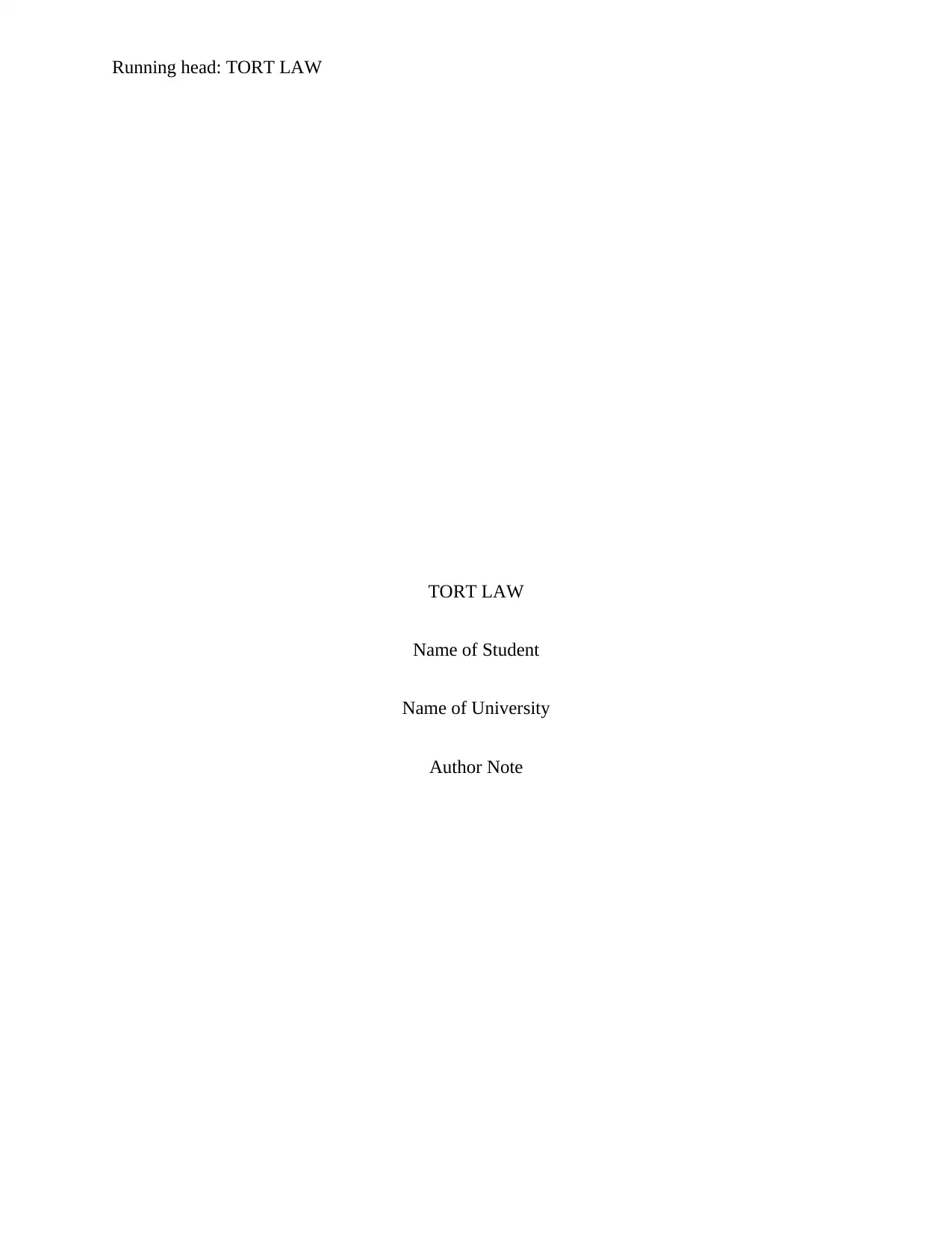
Running head: TORT LAW
TORT LAW
Name of Student
Name of University
Author Note
TORT LAW
Name of Student
Name of University
Author Note
Paraphrase This Document
Need a fresh take? Get an instant paraphrase of this document with our AI Paraphraser
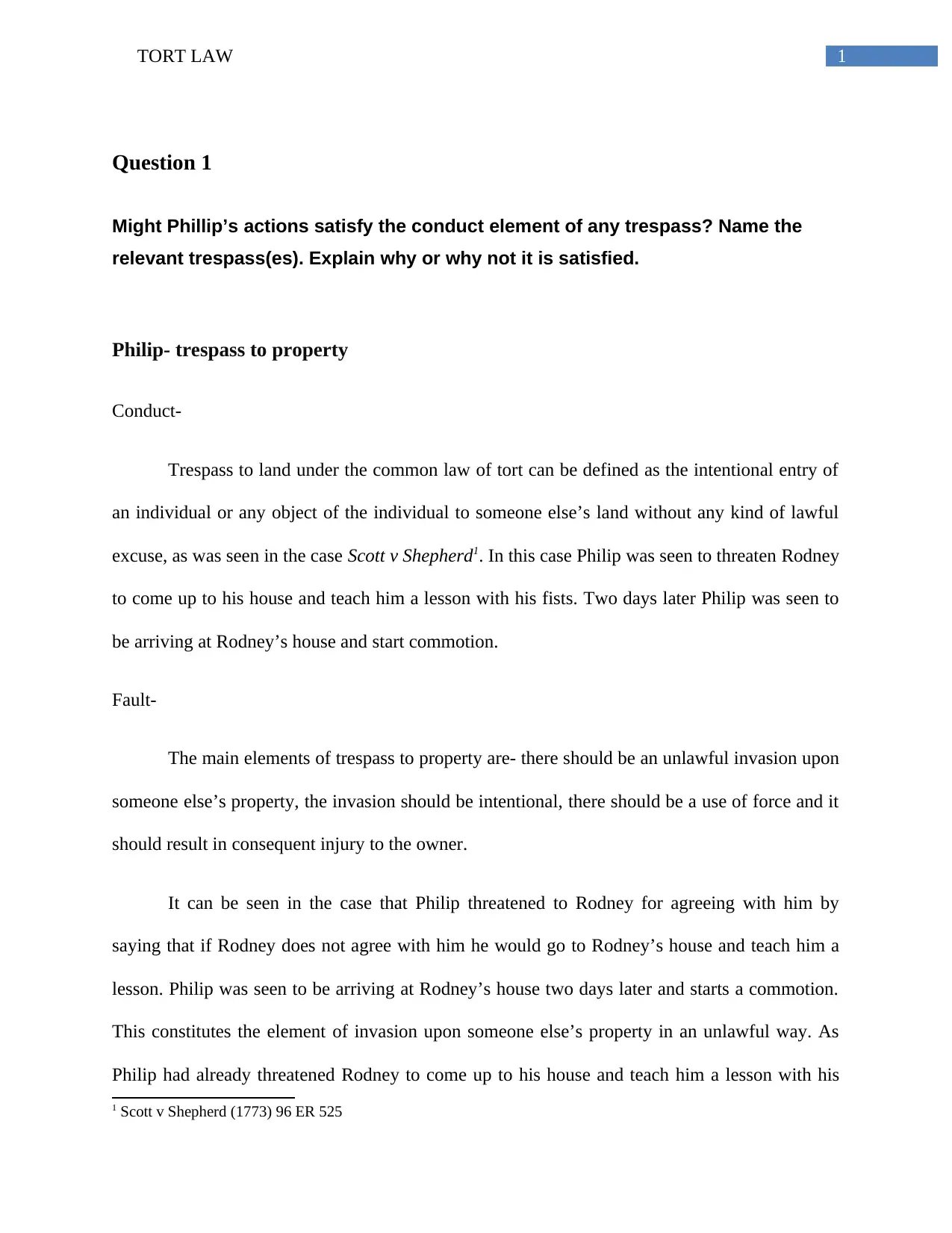
1TORT LAW
Question 1
Might Phillip’s actions satisfy the conduct element of any trespass? Name the
relevant trespass(es). Explain why or why not it is satisfied.
Philip- trespass to property
Conduct-
Trespass to land under the common law of tort can be defined as the intentional entry of
an individual or any object of the individual to someone else’s land without any kind of lawful
excuse, as was seen in the case Scott v Shepherd1. In this case Philip was seen to threaten Rodney
to come up to his house and teach him a lesson with his fists. Two days later Philip was seen to
be arriving at Rodney’s house and start commotion.
Fault-
The main elements of trespass to property are- there should be an unlawful invasion upon
someone else’s property, the invasion should be intentional, there should be a use of force and it
should result in consequent injury to the owner.
It can be seen in the case that Philip threatened to Rodney for agreeing with him by
saying that if Rodney does not agree with him he would go to Rodney’s house and teach him a
lesson. Philip was seen to be arriving at Rodney’s house two days later and starts a commotion.
This constitutes the element of invasion upon someone else’s property in an unlawful way. As
Philip had already threatened Rodney to come up to his house and teach him a lesson with his
1 Scott v Shepherd (1773) 96 ER 525
Question 1
Might Phillip’s actions satisfy the conduct element of any trespass? Name the
relevant trespass(es). Explain why or why not it is satisfied.
Philip- trespass to property
Conduct-
Trespass to land under the common law of tort can be defined as the intentional entry of
an individual or any object of the individual to someone else’s land without any kind of lawful
excuse, as was seen in the case Scott v Shepherd1. In this case Philip was seen to threaten Rodney
to come up to his house and teach him a lesson with his fists. Two days later Philip was seen to
be arriving at Rodney’s house and start commotion.
Fault-
The main elements of trespass to property are- there should be an unlawful invasion upon
someone else’s property, the invasion should be intentional, there should be a use of force and it
should result in consequent injury to the owner.
It can be seen in the case that Philip threatened to Rodney for agreeing with him by
saying that if Rodney does not agree with him he would go to Rodney’s house and teach him a
lesson. Philip was seen to be arriving at Rodney’s house two days later and starts a commotion.
This constitutes the element of invasion upon someone else’s property in an unlawful way. As
Philip had already threatened Rodney to come up to his house and teach him a lesson with his
1 Scott v Shepherd (1773) 96 ER 525
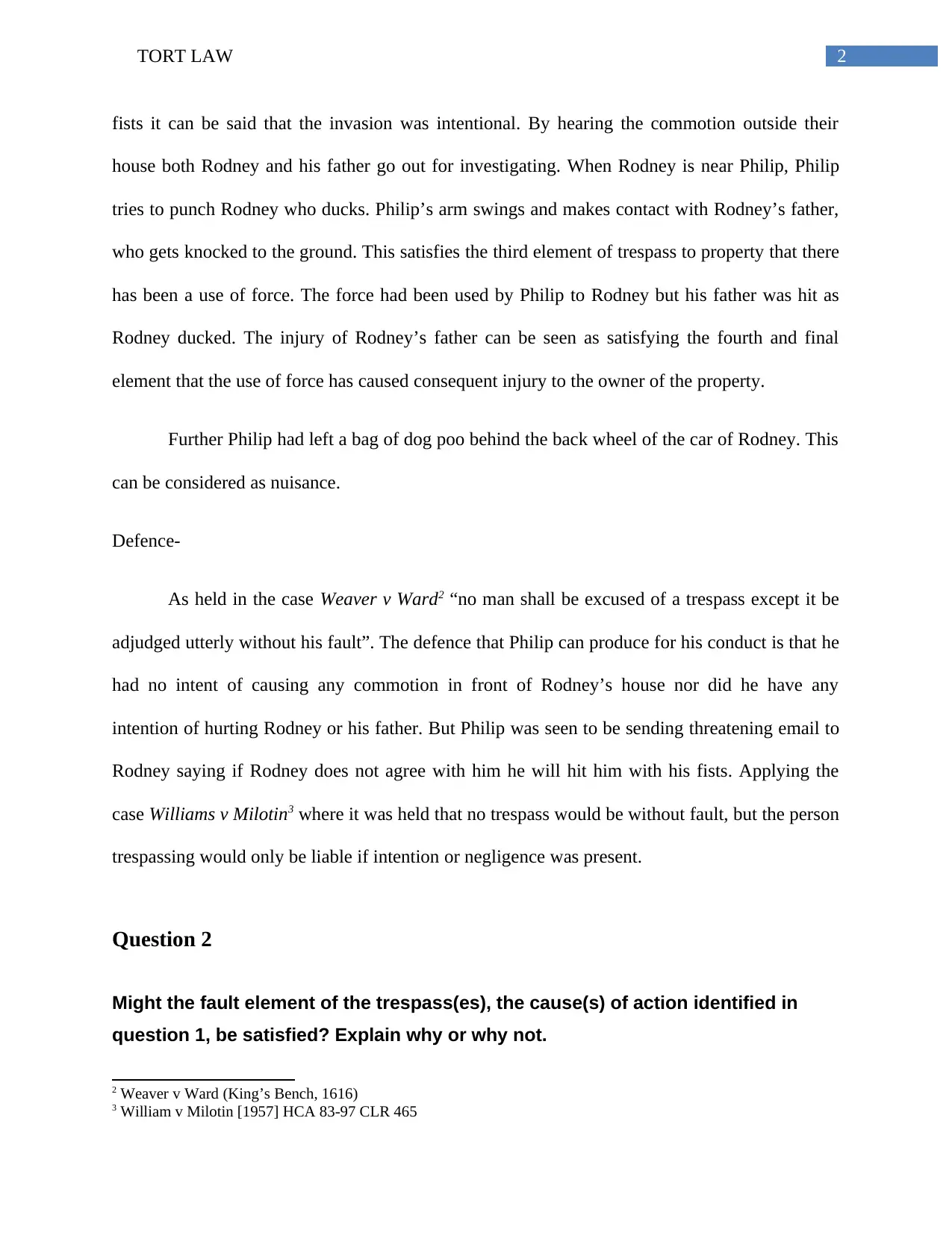
2TORT LAW
fists it can be said that the invasion was intentional. By hearing the commotion outside their
house both Rodney and his father go out for investigating. When Rodney is near Philip, Philip
tries to punch Rodney who ducks. Philip’s arm swings and makes contact with Rodney’s father,
who gets knocked to the ground. This satisfies the third element of trespass to property that there
has been a use of force. The force had been used by Philip to Rodney but his father was hit as
Rodney ducked. The injury of Rodney’s father can be seen as satisfying the fourth and final
element that the use of force has caused consequent injury to the owner of the property.
Further Philip had left a bag of dog poo behind the back wheel of the car of Rodney. This
can be considered as nuisance.
Defence-
As held in the case Weaver v Ward2 “no man shall be excused of a trespass except it be
adjudged utterly without his fault”. The defence that Philip can produce for his conduct is that he
had no intent of causing any commotion in front of Rodney’s house nor did he have any
intention of hurting Rodney or his father. But Philip was seen to be sending threatening email to
Rodney saying if Rodney does not agree with him he will hit him with his fists. Applying the
case Williams v Milotin3 where it was held that no trespass would be without fault, but the person
trespassing would only be liable if intention or negligence was present.
Question 2
Might the fault element of the trespass(es), the cause(s) of action identified in
question 1, be satisfied? Explain why or why not.
2 Weaver v Ward (King’s Bench, 1616)
3 William v Milotin [1957] HCA 83-97 CLR 465
fists it can be said that the invasion was intentional. By hearing the commotion outside their
house both Rodney and his father go out for investigating. When Rodney is near Philip, Philip
tries to punch Rodney who ducks. Philip’s arm swings and makes contact with Rodney’s father,
who gets knocked to the ground. This satisfies the third element of trespass to property that there
has been a use of force. The force had been used by Philip to Rodney but his father was hit as
Rodney ducked. The injury of Rodney’s father can be seen as satisfying the fourth and final
element that the use of force has caused consequent injury to the owner of the property.
Further Philip had left a bag of dog poo behind the back wheel of the car of Rodney. This
can be considered as nuisance.
Defence-
As held in the case Weaver v Ward2 “no man shall be excused of a trespass except it be
adjudged utterly without his fault”. The defence that Philip can produce for his conduct is that he
had no intent of causing any commotion in front of Rodney’s house nor did he have any
intention of hurting Rodney or his father. But Philip was seen to be sending threatening email to
Rodney saying if Rodney does not agree with him he will hit him with his fists. Applying the
case Williams v Milotin3 where it was held that no trespass would be without fault, but the person
trespassing would only be liable if intention or negligence was present.
Question 2
Might the fault element of the trespass(es), the cause(s) of action identified in
question 1, be satisfied? Explain why or why not.
2 Weaver v Ward (King’s Bench, 1616)
3 William v Milotin [1957] HCA 83-97 CLR 465
⊘ This is a preview!⊘
Do you want full access?
Subscribe today to unlock all pages.

Trusted by 1+ million students worldwide
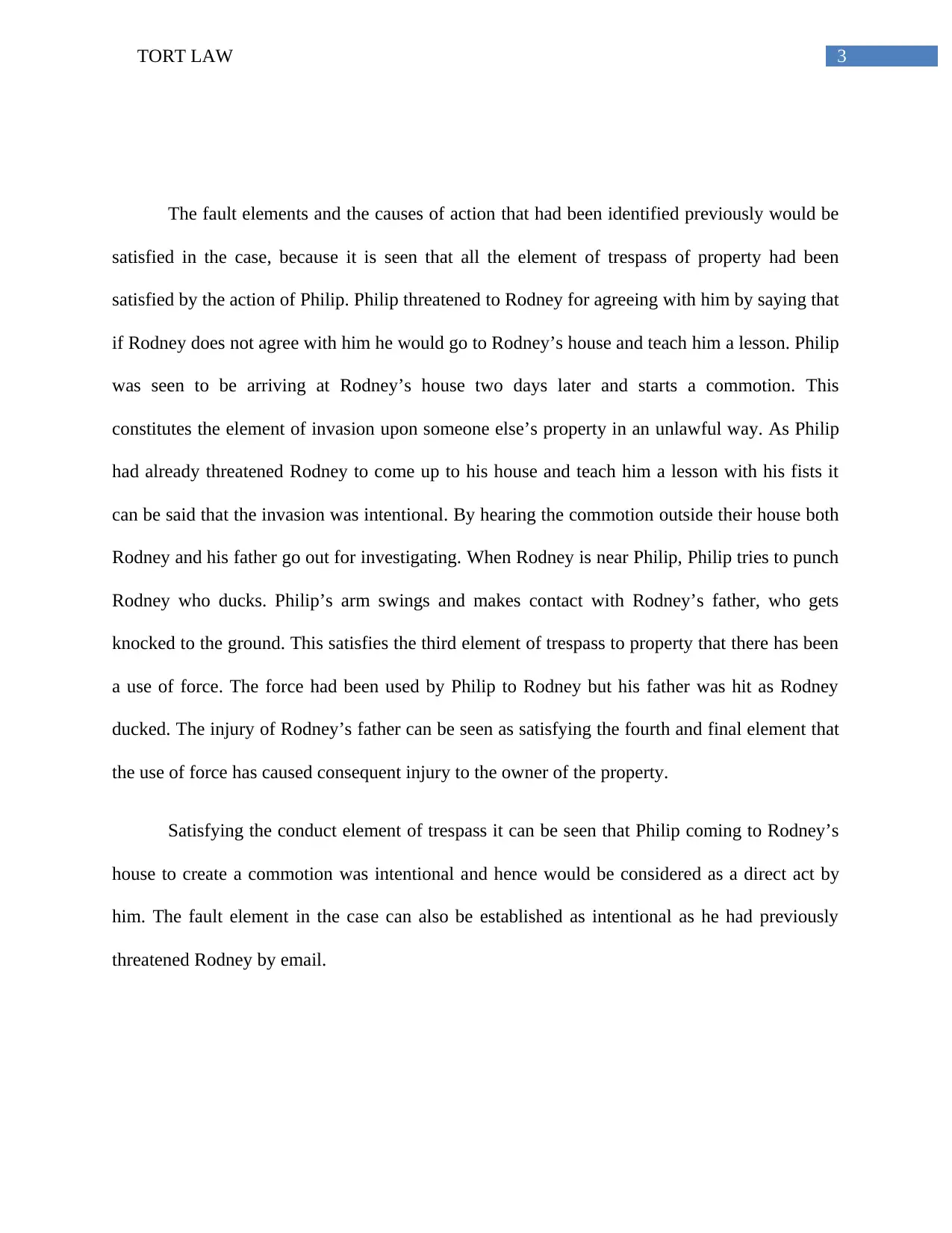
3TORT LAW
The fault elements and the causes of action that had been identified previously would be
satisfied in the case, because it is seen that all the element of trespass of property had been
satisfied by the action of Philip. Philip threatened to Rodney for agreeing with him by saying that
if Rodney does not agree with him he would go to Rodney’s house and teach him a lesson. Philip
was seen to be arriving at Rodney’s house two days later and starts a commotion. This
constitutes the element of invasion upon someone else’s property in an unlawful way. As Philip
had already threatened Rodney to come up to his house and teach him a lesson with his fists it
can be said that the invasion was intentional. By hearing the commotion outside their house both
Rodney and his father go out for investigating. When Rodney is near Philip, Philip tries to punch
Rodney who ducks. Philip’s arm swings and makes contact with Rodney’s father, who gets
knocked to the ground. This satisfies the third element of trespass to property that there has been
a use of force. The force had been used by Philip to Rodney but his father was hit as Rodney
ducked. The injury of Rodney’s father can be seen as satisfying the fourth and final element that
the use of force has caused consequent injury to the owner of the property.
Satisfying the conduct element of trespass it can be seen that Philip coming to Rodney’s
house to create a commotion was intentional and hence would be considered as a direct act by
him. The fault element in the case can also be established as intentional as he had previously
threatened Rodney by email.
The fault elements and the causes of action that had been identified previously would be
satisfied in the case, because it is seen that all the element of trespass of property had been
satisfied by the action of Philip. Philip threatened to Rodney for agreeing with him by saying that
if Rodney does not agree with him he would go to Rodney’s house and teach him a lesson. Philip
was seen to be arriving at Rodney’s house two days later and starts a commotion. This
constitutes the element of invasion upon someone else’s property in an unlawful way. As Philip
had already threatened Rodney to come up to his house and teach him a lesson with his fists it
can be said that the invasion was intentional. By hearing the commotion outside their house both
Rodney and his father go out for investigating. When Rodney is near Philip, Philip tries to punch
Rodney who ducks. Philip’s arm swings and makes contact with Rodney’s father, who gets
knocked to the ground. This satisfies the third element of trespass to property that there has been
a use of force. The force had been used by Philip to Rodney but his father was hit as Rodney
ducked. The injury of Rodney’s father can be seen as satisfying the fourth and final element that
the use of force has caused consequent injury to the owner of the property.
Satisfying the conduct element of trespass it can be seen that Philip coming to Rodney’s
house to create a commotion was intentional and hence would be considered as a direct act by
him. The fault element in the case can also be established as intentional as he had previously
threatened Rodney by email.
Paraphrase This Document
Need a fresh take? Get an instant paraphrase of this document with our AI Paraphraser
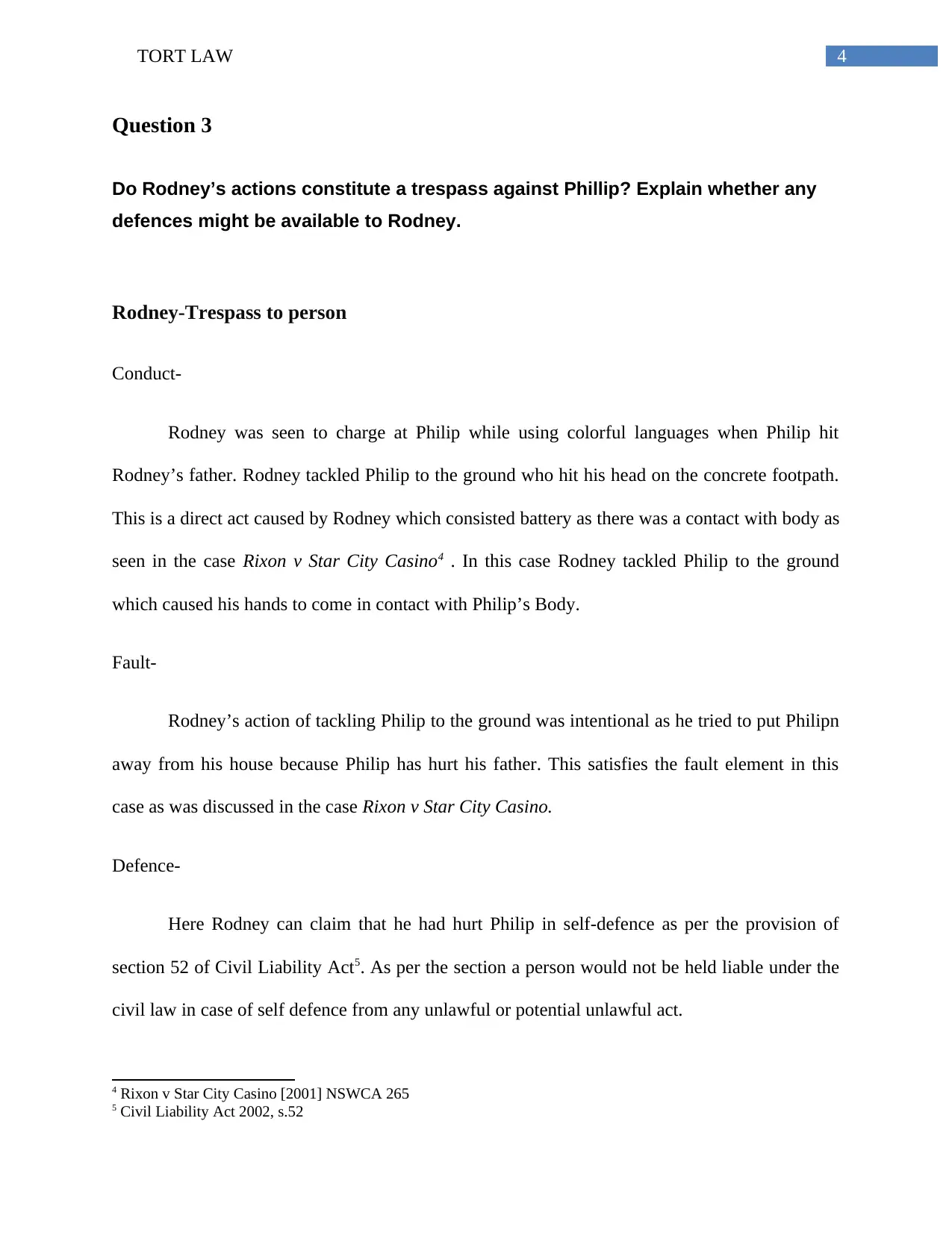
4TORT LAW
Question 3
Do Rodney’s actions constitute a trespass against Phillip? Explain whether any
defences might be available to Rodney.
Rodney-Trespass to person
Conduct-
Rodney was seen to charge at Philip while using colorful languages when Philip hit
Rodney’s father. Rodney tackled Philip to the ground who hit his head on the concrete footpath.
This is a direct act caused by Rodney which consisted battery as there was a contact with body as
seen in the case Rixon v Star City Casino4 . In this case Rodney tackled Philip to the ground
which caused his hands to come in contact with Philip’s Body.
Fault-
Rodney’s action of tackling Philip to the ground was intentional as he tried to put Philipn
away from his house because Philip has hurt his father. This satisfies the fault element in this
case as was discussed in the case Rixon v Star City Casino.
Defence-
Here Rodney can claim that he had hurt Philip in self-defence as per the provision of
section 52 of Civil Liability Act5. As per the section a person would not be held liable under the
civil law in case of self defence from any unlawful or potential unlawful act.
4 Rixon v Star City Casino [2001] NSWCA 265
5 Civil Liability Act 2002, s.52
Question 3
Do Rodney’s actions constitute a trespass against Phillip? Explain whether any
defences might be available to Rodney.
Rodney-Trespass to person
Conduct-
Rodney was seen to charge at Philip while using colorful languages when Philip hit
Rodney’s father. Rodney tackled Philip to the ground who hit his head on the concrete footpath.
This is a direct act caused by Rodney which consisted battery as there was a contact with body as
seen in the case Rixon v Star City Casino4 . In this case Rodney tackled Philip to the ground
which caused his hands to come in contact with Philip’s Body.
Fault-
Rodney’s action of tackling Philip to the ground was intentional as he tried to put Philipn
away from his house because Philip has hurt his father. This satisfies the fault element in this
case as was discussed in the case Rixon v Star City Casino.
Defence-
Here Rodney can claim that he had hurt Philip in self-defence as per the provision of
section 52 of Civil Liability Act5. As per the section a person would not be held liable under the
civil law in case of self defence from any unlawful or potential unlawful act.
4 Rixon v Star City Casino [2001] NSWCA 265
5 Civil Liability Act 2002, s.52

5TORT LAW
⊘ This is a preview!⊘
Do you want full access?
Subscribe today to unlock all pages.

Trusted by 1+ million students worldwide
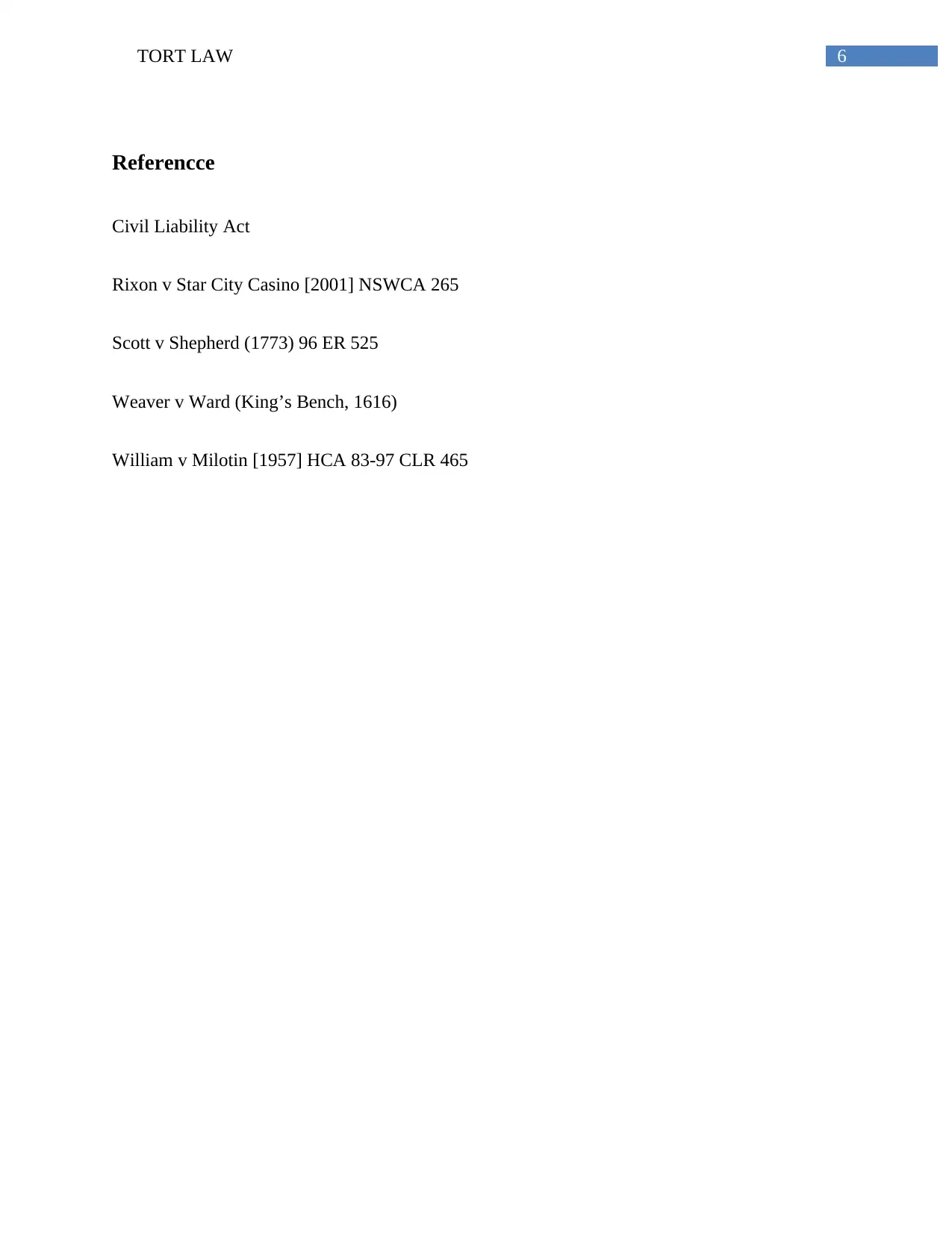
6TORT LAW
Referencce
Civil Liability Act
Rixon v Star City Casino [2001] NSWCA 265
Scott v Shepherd (1773) 96 ER 525
Weaver v Ward (King’s Bench, 1616)
William v Milotin [1957] HCA 83-97 CLR 465
Referencce
Civil Liability Act
Rixon v Star City Casino [2001] NSWCA 265
Scott v Shepherd (1773) 96 ER 525
Weaver v Ward (King’s Bench, 1616)
William v Milotin [1957] HCA 83-97 CLR 465
1 out of 7
Your All-in-One AI-Powered Toolkit for Academic Success.
+13062052269
info@desklib.com
Available 24*7 on WhatsApp / Email
![[object Object]](/_next/static/media/star-bottom.7253800d.svg)
Unlock your academic potential
© 2024 | Zucol Services PVT LTD | All rights reserved.
